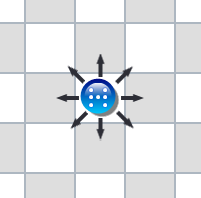
The board contains 11 ranks (rows) and 9 files (columns). Each side have 10 pieces, numbered from 0 to 9. The board initial layout is set as the picture below.

Movement: Each piece (with the exception of 0 piece) can move in any direction (vertically, horizontally, or diagonally - forward or backward), the max number of squares a piece can move depends on the number of the piece. For example, the piece with number 2 can move 1 or 2 empty squares, while the piece with number 9 can move from 1 to 9 empty squares...

Capture: to capture the opponent's piece, player must have 2 pieces one next to another. Then use the numbers of the 2 pieces to make calculations. Allowed calculations are + (addition), - (subtraction), x (multiplication), : (division), and division remainder. Any result of the calculations can be used to apply to the capture. If a result contain 2 numbers then remove the tens number (for example 8 x 7 = 56 => use 6). Use a suitable result to make the capture by taking the piece behind to capture opponent's piece.
For example, player have an 8 piece and 5 piece next to each other vertically. Calculation results from these 2 pieces are:
8 + 5 = 13 (take 3)
8 - 5 = 3
8 x 5 = 40 (take 0 - which is useless anyway)
8 : 5 = 1 with 3 as remainder (take both 1 and 3)
Player can then use the 8 piece (the piece behind) to capture an opponent piece which is 1 or 3 squares away from the 5 piece (the piece on front), in same the direction that 8 -> 5 is.
The image below show how the 1 piece and 2 piece standing next to each other can capture opponent pieces. If an opponent piece is on one of those X squares, player can capture it. The calculations that the capture is based on are: 1 + 2 = 3, 1 x 2 = 2, 1 : 2 = 0 with 1 as remainder.

The 0 piece (the one with zero number) is like the King in International chess. When it is captured, player loses the game.
Besides capturing 0 piece, players can agree on a certain point for ending a match (if the 0 piece is not captured before that point is reached). The point that one player gains is calculated by summing the numbers of the opponent's pieces that have been captured.
For example, if the players agree to set the match's ending point to 10. Then when a player captures the 5 and 6 piece, he wins the game (5 + 6 = 11 which is greater than 10). Or if a player captures the 0 piece then he also wins.